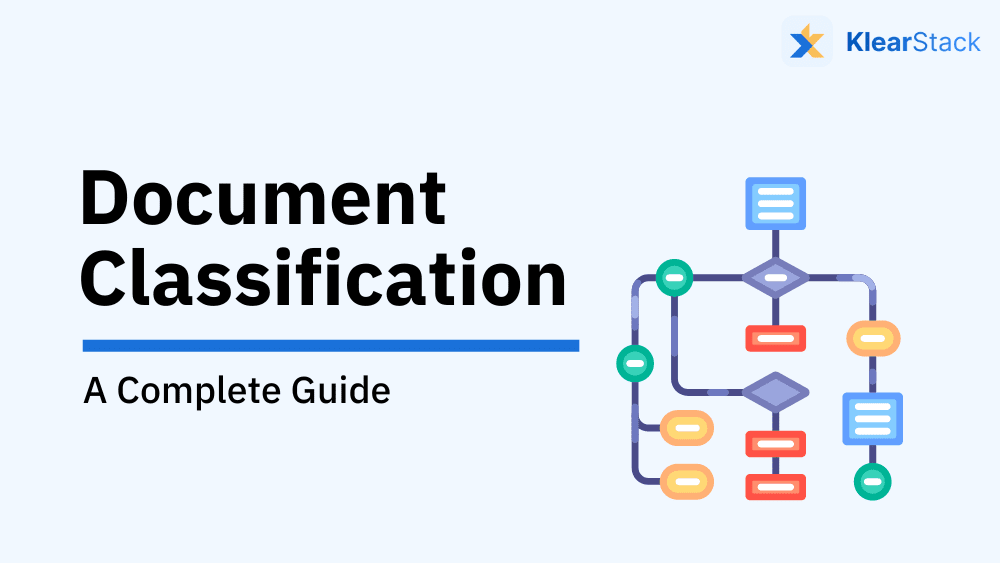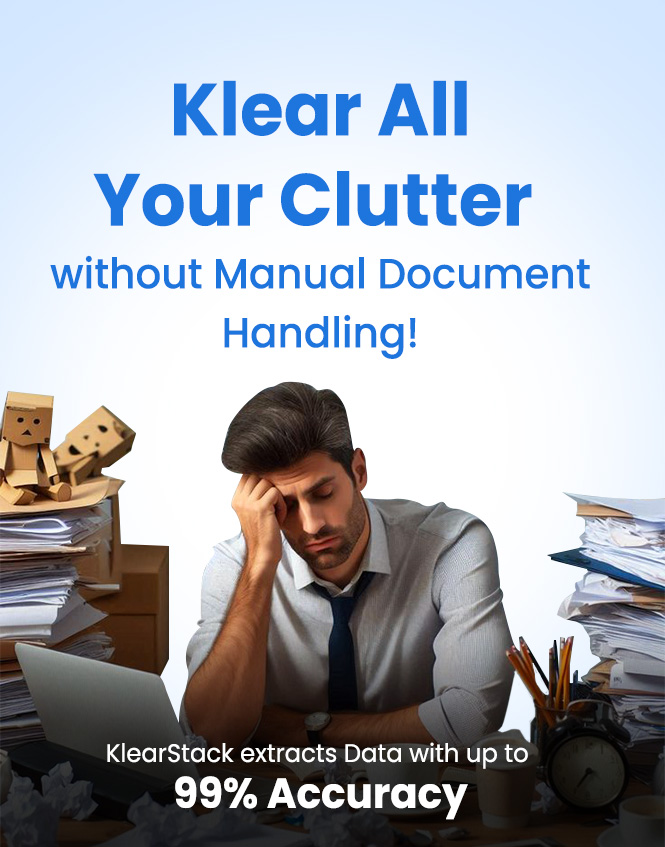Global data creation will exceed 394 zettabytes by 2028 (Report by Statista). At the same time, staff still spend 1.8 hours every day hunting for information (Stats from Proprofskb). The gap between soaring data and slow retrieval hurts speed, compliance, and margins.
Document classification brings order by adding a label the moment a file arrives.
- Can a bank officer trace a six‑month‑old statement in seconds?
- Will an auditor accept your tag history without question?
- Does the service desk open the right PDF on the first try?
These questions drive the shift to automated document classification. This guide shows how the method works, which tech powers it, and how enterprises can launch a robust program without heavy jargon.
We wrote this guide to answer those points. It shows the math, the tools, and the proven steps for turning raw files into ready insight.
Key Takeaways
- Automated document classification groups files by content, layout, or visuals in seconds.
- Core tech includes OCR, NLP, and computer vision working in concert.
- Supervised, unsupervised, and hybrid models cover every data scenario.
- Clear KPIs, accuracy, processing time, cost per file and prove ROI fast.
- KlearStack offers template‑free extraction, self‑learning AI, and 99 % accuracy for high‑volume teams.
What Is Document Classification?

Document classification assigns each file to a predefined category. A policy PDF lands under “Compliance,” a bill of lading under “Logistics.”
Automated document classification applies algorithms instead of clerks. That shift converts messy drives into structured libraries. Search, analytics, and audit all gain speed because the right label already sits on every record.
The next sections show why that label matters and how the pipeline works.
How Document Classification Works
1. Data Ingestion & OCR
Files enter by email, API, or scanner. OCR converts images or PDFs into text while keeping line positions. Confidence scores flag unreadable areas for review, so no blind spots remain.
2. Feature Extraction & Vectorisation
NLP strips stop words, stems verbs, and builds embeddings. Computer vision maps tables, logos, and stamps. The result is a numeric vector that holds both meaning and layout in under 1 KB.
3. Model Selection & Training
Supervised models learn from labelled sets; clustering finds hidden groups in unlabeled piles. A small validation slice measures precision, recall, and F1 before go‑live.
4. Real‑Time Inference & Feedback
New vectors hit the model through a REST call and return a label plus score.
A 5 % sample routes to humans each week; corrections feed the next training cycle.
5. Storage & Integration
Final tags flow to DMS, ERP, or CRM platforms. APIs post metadata so search, billing, and analytics tools work from one source of truth.
This five‑step loop turns any file stream into a structured, searchable asset.

Common Document Types You Can Classify Automatically
Automation handles both text‑heavy and visual files. Below are the most frequent groups, each processed with the same pipeline described earlier.
- Financial: invoices, receipts, credit notes, purchase orders
- Identity & KYC: passports, driver licences, utility bills, ID cards
- Legal & Compliance: contracts, NDAs, court filings, policy manuals
- Healthcare: lab reports, prescriptions, insurance claims, discharge summaries
- Logistics: bills of lading, packing lists, certificates of origin, delivery notes
- HR & Payroll: résumés, timesheets, payslips, appraisal forms
- Customer Support: tickets, chat logs, email threads, warranty forms
A short closing line: these categories cover over 80 % of enterprise document traffic, so start where the volume lives.
Industry Use‑Cases & Applications
Banking: Know‑Your‑Customer & Fraud Watch
Passports, utility bills, and pay slips land under the right case file instantly.
One Asian bank cut KYC turnaround from 48 hours to 4 hours after launch.
Insurance: Multi‑Line Claim Routing
Models tag auto, health, and property claims. Each claim reaches a line expert first time.
Adjuster idle time dropped by 40 % in a mid‑size carrier.
Logistics: Trade Document Handling
Bills of lading, packing lists, and certificates reach customs desks automatically.
Late‑fee spend at ports fell by 15 % within a quarter.
Healthcare: Patient Record Tagging
Labs, imaging, and consent forms receive standard codes. Clinicians locate history in one search. Readmission rates dipped as staff caught missing allergies faster.
Public Sector: Permit and Case Files
Zoning forms, tax filings, and court orders route by type and jurisdiction.
Citizens track status online without extra calls, raising service scores.
Each field shows a clear win: faster service, lower cost, and stronger oversight.
Implementation Roadmap & Best Practices
Implementation projects often stall when teams jump from pilot talk to full roll‑out without a clear path. A short, phased roadmap keeps risk low, builds trust, and locks in early wins.
Use the framework below as a checklist that guides every stage — from sample collection to continuous tuning — so the model stays accurate and the business keeps seeing value.
Step‑by‑Step Plan
- Scope. Pick one high‑volume class and define success metrics.
- Collect. Gather 20–50 samples per label; remove sensitive data.
- Label. Use dual reviewers to hit ≥ 98 % agreement.
- Train. Run baseline supervised model; log precision and recall.
- Pilot. Deploy to a limited queue; compare auto vs. human tags daily.
- Expand. Add classes once accuracy stays above target for two weeks.
Best‑Practice Tips
- Keep a human‑in‑the‑loop until the model sees 1,000+ files.
- Store vectors, not raw text, if privacy rules demand it.
- Schedule re‑training monthly or when accuracy dips two points.
Finish the rollout with change workshops so staff trust the new tags.
Challenges & ROI Calculation
Technical Hurdles
- Template Drift. Vendors change invoice layouts; retrain quarterly.
- Bias Risk. Uneven samples skew results; balance classes early.
- Latency. Large models add lag; use GPU or distill models for edge use.
Governance and Security
Encrypt data in transit and at rest.
Keep audit logs for every prediction to satisfy regulators.
ROI Math
Use this formula:
ROI % = (Manual Cost – Automated Cost) ÷ Automated Cost × 100
Example: Manual tagging costs $50 000 a quarter. Automation costs $15 000.
ROI = (50 – 15) ÷ 15 × 100 = 233 % within three months.
Continuous Value
Savings grow as volumes rise and models learn.
Most firms see payback in under six months, then enjoy compounding returns.
Why Should You Choose KlearStack?
Document‑heavy teams need a partner, not just code. KlearStack fits that need.
Solutions that fit
- Template‑free extraction reads any layout.
- Self‑learning AI raises accuracy with each file.
- Real‑time validation blocks bad data at the gate.
Proven impact
- 99 % extraction accuracy on mixed invoices.
- 500 % efficiency lift for a global logistics client.
- 85 % cost savings across finance teams.
Key capabilities
- Intelligent field capture with no regex rules.
- Auto‑classification and auto‑splitting.
- Secure hosting that meets GDPR and DPDPA.

Conclusion
Automated document classification turns scattered files into structured assets. Firms gain faster search, lower spend, and stronger compliance.
Adopt the right model, pair it with OCR, NLP, and computer vision, and watch processing time fall. The payoff is clear: less manual work, more insight, and happier customers.
Business wins
- Faster decisions from instant file retrieval.
- Fewer fines through accurate access control.
- Higher staff focus on value tasks.
- Measurable savings within one budget cycle.
FAQs on Document Classification
Automated document classification uses algorithms to label files without manual effort.
Machine learning learns patterns from samples, then repeats them consistently across new files.
Banking, insurance, logistics, and healthcare handle high volumes and see quick returns.
KlearStack runs encrypted workflows and follows GDPR and DPDPA, keeping data safe.






